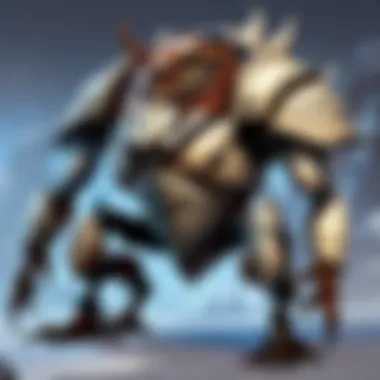Combatting Bugs in Blizzard Games: A Comprehensive Guide


Intro
The issue of bugs in gaming, particularly in titles developed by Blizzard, is a persistent concern for players. Bugs can disrupt the gaming experience, sometimes making it frustrating or unplayable. Understanding the origins and resolutions for these bugs is crucial for players aiming to enhance their gaming sessions. This article will explore various aspects related to bugs in Blizzard games, including their types, how they affect gameplay, and the steps players can take to address these issues.
We will also delve into the role of community feedback, Blizzard's dedication to refining their games through updates, and the overall player experience. Equipped with this knowledge, players can better navigate the challenges posed by bugs, thus fostering a more enjoyable gaming environment.
Game Updates and Patch Notes
Blizzard is known for its commitment to crafting polished gaming experiences. To assure quality, they frequently release game updates. These updates often contain essential bug fixes that play a significant role in improving game performance.
Overview of Recent Game Updates by Blizzard
In recent months, Blizzard has launched several notable updates across its major titles, including World of Warcraft and Overwatch 2. Each update is a response to community feedback and aims to rectify common issues. For instance, patches may target connectivity problems or specific glitches that players have reported. Regular updates help maintain community trust, as players see a proactive approach toward claims and repairs.
Detailed Breakdown of Patch Notes and Changes
Patch notes are critical in understanding what has changed in a game. Blizzard's patch notes tend to provide a list of fixes and tweaks. Players can find details about character adjustments, weapon balancing, and bug fixes all in one place. By analyzing patch notes from a recent update, players can pinpoint when certain bugs were addressed, which enhances their understanding of the game's evolution.
Analysis of Impact on Gameplay and Community Feedback
Each patch not only introduces fixes but can also shift the overall gameplay dynamics. For example, if a character expression has been adjusted, it may result in major changes during competitive play. Community feedback plays a vital role in this process. Players often take to forums and social media platforms like Reddit or Facebook to discuss their experiences and offer insights on updates. This feedback loop between Blizzard and the player community fosters a culture of continuous improvement, ultimately leading to better gaming experiences.
"Regular updates keep the community engaged and show that Blizzard values player input in shaping their games."
Epilogue
The journey in tackling bugs in Blizzard games involves understanding the current landscape of updates, player feedback, and the commitment of the developers to create a refined experience for all players. Recognizing these aspects can significantly elevate the gaming experience, ensuring that challenges posed by bugs are addressed in a timely and efficient manner.
As we navigate through this guide, we will further explore community strategies, troubleshooting methods, and historical perspectives on bug management in Blizzard’s diverse game library.
Foreword to Bugs in Gaming
Understanding bugs in gaming is fundamental for both developers and players. It shapes the player experience, and it informs how developers address and prevent these issues. This section serves as a prelude to the intricate details discussed throughout the article. It emphasizes the significance of recognizing and managing bugs, particularly within Blizzard's games, which are known for their immersive environments and complex mechanics.
Definition of Game Bugs
Bugs in video games are unintended errors or glitches in the software that can disrupt gameplay. These can manifest in various forms, affecting graphics, player actions, or the game world itself. Common examples include texture errors, character pathfinding issues, and crashes.
Each type of bug can carry a different weight in terms of severity. Some may cause minor inconveniences, like visual anomalies, while others can completely halt a player's progress or ruin the balance in a competitive setting. A precise definition helps in identifying the scope of the problem and its potential effects on the overall gaming experience.
Why Bugs Occur
The occurrence of bugs in video games is often tied to several factors. One significant aspect is the complexity of modern games. Advanced graphics and interactive elements require extensive coding, which increases the likelihood of errors.
Other contributing factors include:
- Software Updates: Regular patches can inadvertently introduce new bugs. The process of altering code can have unforeseen consequences.
- Resource Limitations: Developers sometimes work under tight deadlines, which can lead to less testing and compromising on quality assurance.
- User Inputs: Players can interact with games in unpredictable ways, revealing bugs that developers did not anticipate.
This section highlights the multifaceted reasons behind bugs in gaming, establishing a groundwork that enables readers to comprehend the subsequent discussions on specific bugs within Blizzard's offerings.
Types of Bugs in Blizzard Games
The presence of bugs in video games, particularly in titles from Blizzard, is an important topic. Understanding the types of bugs provides insights into how they affect the player experience. This section will delve into the common bugs encountered in Blizzard games. It serves as a primer for players to recognize and potentially troubleshoot these issues. Knowing about the different kinds of bugs can enable gamers to report them more effectively, leading to quicker resolutions.
Graphical Glitches
Graphical glitches are among the most recognizable types of bugs faced by players. These issues manifest as visual artifacts, screen tearing, texture pop-ins, or even complete freezes. Players might encounter scenarios where characters appear distorted or textures fail to load properly.
Such glitches can hinder immersion, affecting narrative and gameplay enjoyment.
To mitigate these issues, players can try a few approaches:
- Ensure that their graphics drivers are updated.
- Lower the in-game graphics settings.
- Check for any conflicts with other software running in the background.
- Reporting persistent graphical bugs with a detailed description can assist Blizzard in addressing them swiftly.


Gameplay Bugs
Gameplay bugs involve errors within the game mechanics themselves. Examples include characters falling through the map, quests not triggering properly, or abilities not functioning as intended. These issues can significantly impact a player's ability to progress in the game.
The importance of gameplay bugs cannot be understated. A broken quest can lead to frustration and disengagement. To address gameplay bugs, players should:
- Document the conditions under which the bug occurs.
- Restart the game to see if the bug persists.
- Visit forums like Reddit for user-shared solutions or workarounds.
Reporting system errors can help Blizzard identify trends and prioritize fixes effectively.
Server Issues
Server issues can affect online gameplay, leading to lag, disconnections, or even matchmaking problems. These types of bugs are often influenced by server load or downtime due to maintenance. Server issues can lead to player dissatisfaction, particularly in competitive environments like Overwatch or Diablo.
To manage expectations during server down times, players can:
- Check official Blizzard channels for maintenance updates.
- Join forums to see if other players are experiencing similar issues.
- Remain patient when server issues arise, understanding that they are often resolved swiftly by Blizzard's technical team.
Server stability is crucial for maintaining a seamless gaming experience, thus highlighting the need for players to stay informed.
Identifying Bugs in Blizzard Games
Understanding how to identify bugs in Blizzard games is crucial for both players and developers. Bugs can disrupt gameplay and severely affect user satisfaction. Identifying these issues early allows players to report them, and as a result, aids Blizzard in their efforts to resolve them. Awareness of bugs enhances the overall gaming experience, as it can lead to timely fixes and patches.
Recognizing Symptoms of Bugs
When experiencing bugs, players should know how to recognize the symptoms. Some typical symptoms include:
- Unresponsive controls: Characters might not respond to input as expected, causing frustration during gameplay.
- Visual glitches: In-game textures might flicker or appear incorrectly, impacting immersion.
- Crashes: The game may suddenly stop running, which can lead to lost progress.
- Sound issues: Audio may not sync correctly, creating a disconnect from the gameplay experience.
Awareness of these symptoms helps players to identify when they are encountering bugs, enabling them to act appropriately.
Common Scenarios and Examples
There are various scenarios where players often encounter bugs in Blizzard titles. Here are some examples that illustrate these bugs:
- Overwatch: Players have reported issues such as heroes appearing stuck in a certain animation or not being able to use abilities intermittently.
- World of Warcraft: Quest items sometimes fail to appear, or players find themselves unable to complete objectives due to bugs.
- Diablo III: Players might notice items duplicating or disappearing from their inventories after a patch.
In these situations, reporting can proactively help the developer to address issues swiftly. Players can utilize forums or feedback channels to communicate their experiences.
Impact of Bugs on Gameplay
The influence of bugs in Blizzard games extends beyond simple technical failures. Understanding the impact of these bugs on gameplay is critical to recognizing how they can affect the overall experience of players and the integrity of the games themselves. Through investigating the implications, it becomes clear that bugs can disrupt player engagement and fairness in competitive environments.
Player Experience Disruption
Bugs can significantly disrupt a player’s gaming experience. For many, gaming is not just an activity, but a passion. When bugs manifest, they can lead to frustrations that hinder enjoyment.
Common types of disruptions may include:
- Unexpected crashes that can lead to loss of progress.
- Inability to access certain features, like in-game events or rewards.
- Visual glitches that detract from immersion.
When players encounter bugs like these, it can lead to immediate dissatisfaction. This dissatisfaction often results in decreased engagement with the game. If bugs persist, players may abandon Blizzard titles altogether.
"Understanding the player experience disrupted by bugs is essential in keeping a loyal player base."
Competitive Balance Issues
Competitive balance is a foundation of multiplayer gaming. Bugs that create unfair advantages or disadvantages can skew gameplay and lead to distrust within the community. Bugs can particularly affect the competitive integrity of games like Overwatch or World of Warcraft. Examples include:
- Weapon or character imbalances that arise from glitches, affecting player performance.
- Server lag causing disparities in reaction times, creating a flawed competitive environment.
The presence of bugs can breed frustration that goes beyond casual annoyance. Players who feel that they lost due to issues outside their control may become disillusioned. In competitive gaming, maintaining fairness is crucial.
Overall, understanding these impacts deepens the appreciation of how critically important it is for Blizzard to address bugs effectively. By creating a more stable environment, Blizzard not only enhances player experience but also upholds competitive integrity.
Blizzard's Approach to Bug Fixing
Bugs can disrupt gameplay and alter the experience for gamers. Blizzard has established a systematic approach for their resolution. This process plays a crucial role in ensuring player satisfaction. Recognizing the intricate nature of multiplayer environments, Blizzard understands that timely fixes are necessary. Their approach combines player feedback, analytical data, and ongoing testing. This helps in identifying weak points that may contribute to bugs.


Patching Processes Overview
Patching is a staple in Blizzard's strategy to address bugs. Each patch is like a safety net, aimed at catching unforeseen issues that arise during gameplay. These patches undergo rigorous testing before they are pushed out to the public. Blizzard utilizes both internal testing teams and select community members to evaluate the patches.
The process begins with the identification of a bug either through player reports or internal discovery. Once a bug is flagged, Blizzard's developers prioritize the issue based on its severity. Simultaneously, they work on a solution to fix the bug. After coding the fix, the patch enters a testing phase. Here are the critical steps in the patching process:
- Identification: Gather and prioritize bugs reported by players and internal QA.
- Development: Code changes implemented to address specific issues.
- Testing: Rigorous testing in various environments to ensure the fix works without creating new problems.
- Release: Deploy the patch to the game servers and monitor its impact.
By maintaining this structured process, Blizzard aims to minimize interruptions to gameplay and ensure a smoother gaming experience.
Quality Assurance Measures
Quality assurance (QA) is integral to Blizzard's effort in bug resolution. The company employs a multi-tiered approach to QA that extends beyond mere testing. QA encompasses every development phase, from initial design to post-release monitoring. The focus is on delivering high-quality products consistently.
QA teams conduct various tests including:
- Functional Testing: Ensures the game functions as intended across platforms.
- Performance Testing: Examines how well the game operates under various loads.
- Usability Testing: Validates that the user interface is intuitive and user-friendly.
- Regression Testing: Confirms that new patches do not reintroduce any resolved bugs.
By embedding QA deeply into the development process, Blizzard can mitigate potential bugs before they affect the player experience. This proactive stance not only improves the game but also reinforces player trust in Blizzard's commitment to quality.
Community Involvement in Bug Reporting
Community involvement plays a critical role in identifying and fixing bugs in Blizzard games. Players, often encountering diverse bugs during gameplay, can provide valuable insights that help developers understand the issues better. This communication creates a loop where developers can quickly address bugs based on real-time player feedback.
Involving the community in bug reporting offers myriad benefits. First, it fosters a deeper connection between players and developers. When players feel their voices are heard, they are more likely to remain engaged with the game and its community. Furthermore, it allows for quicker resolutions. Developers can prioritize fixes based on the severity and frequency of the reported issues.
Another aspect is the diversity of player experiences. Each player's gaming environment can vary significantly. Factors such as hardware, software, and individual play styles all contribute to unique bugs. By extracting feedback from a range of players, developers can gain a more holistic view of the problem-solving process.
In sum, community involvement in bug reporting enhances the overall gaming experience and ensures that Blizzard can maintain a more stable product.
Feedback Systems
Feedback systems are essential for the efficient functioning of community involvement. They provide structured platforms for players to report bugs. Blizzard employs various systems, including in-game reporting features that allow players to flag issues directly as they encounter them. This immediacy ensures that problems are logged quickly and can be addressed in future patches.
Players can also utilize feedback forms on Blizzard's official website. This method allows for detailed descriptions of issues, providing developers with context that may not be apparent from in-game reports alone.
"Effective feedback systems are crucial; they turn player frustration into actionable data for developers."
User Forums and Discussions
User forums are another vital aspect of community involvement. Platforms like Blizzard's official forums and Reddit serve as gathering places where players can share their experiences with bugs. These discussions often lead to the identification of common problems, allowing players to unite around specific issues. Through these discussions, players can share solutions or workarounds while developers can monitor trends to prioritize fixes.
Additionally, forums create a sense of community. Players often assist one another with troubleshooting, thus reducing frustration. Blizzard can also engage with these discussions, offering official responses to clarify any misunderstandings or provide updates on known issues.
In essence, user forums act as both a support network and a feedback channel. They enhance the relationship between players and developers, ultimately leading to improved game quality.
Troubleshooting Common Bugs
Troubleshooting common bugs is a crucial aspect of the gaming experience in Blizzard's titles. When players encounter issues, understanding how to address them can enhance their overall enjoyment and reduce frustration. Many gamers spend hours in a game, and it is disheartening when bugs disrupt the flow. Thus, being equipped with the ability to identify and resolve common issues can significantly improve the experience.
Engaging in troubleshooting empowers players. It allows them to take control of their gaming environment. Furthermore, it establishes a deeper connection with the game. By understanding the mechanics behind certain bugs, players can contribute to their resolution and become knowledgeable advocates within the gaming community. This section outlines essential guides and frequently asked questions that guide players through the troubleshooting process.
Step-by-Step Guides for Players
When a bug occurs in a Blizzard game, trying systematic troubleshooting steps can often lead to a resolution. Here are some common steps players might consider:
- Identify the Bug: Recognizing the specific issue is the first priority. Is it a graphical glitch, server issue, or gameplay anomaly?
- Check Online Resources: Platforms like Reddit and Blizzard’s support pages can offer initial insights into recurring problems.
- Restart the Game: A simple restart can sometimes clear up temporary issues, refreshing the game state.
- Update the Game: Ensure the latest patches are installed, as many bugs are addressed in updates.
- Verify Game Files: For those playing on PC, using tools offered by Battle.net to verify game files can fix corrupted data.
- Adjust Settings: Altering graphics settings might resolve performance-related bugs.
- Reinstall the Game: As a last resort, a full reinstallation can resolve persistent issues that other methods do not.
These steps, although simple, can dramatically improve gameplay stability and enhance an overall positive experience.
Questions and Answerss on Bug Fixing


Players likely have numerous questions when they encounter bugs in their games. Below are some of the common inquiries:
- What should I do if I encounter a bug? Start by documenting the issue. Take screenshots or notes and then follow the troubleshooting steps discussed earlier.
- Where can I report bugs? Blizzard provides various forums and user support pages where players can report specific issues and find solutions.
- How long does it take for a bug to be fixed? The timeline varies. Some issues may be resolved in hours with a patch, while others might take weeks or months depending on complexity.
- Will I be compensated for in-game bugs? Compensation often depends on the nature of the issue. Blizzard may grant rewards or offers based on the specific situation and how it affects gameplay.
Preventive Measures
In the landscape of Blizzard games, navigating through bugs can often be frustrating. Preventive measures are essential in reducing the likelihood of encountering these issues. By understanding how to prevent bugs, players can enhance their gaming experience and minimize potential disruptions.
Staying Updated with Patches
One of the most critical steps in preventing bugs is ensuring that your game is updated with the latest patches. Blizzard regularly releases updates that address known issues, improve performance, and introduce new content. Staying current with these patches not only fixes existing bugs, it also helps to prevent future ones.
To keep your game updated:
- Enable automatic updates where applicable, so you won't miss any notifications.
- Regularly check Blizzard’s official website or launcher for announcements.
- Join community forums where players discuss updates and share their experiences.
Fulfilling these practices ensures your software remains in optimal condition. It also helps the community developers identify persistent problems by observing how updates influence gameplay.
System Maintenance Recommendations
Maintaining your gaming system can significantly decrease bugs and performance issues. Common recommendations include:
- Regular System Updates: Ensure the operating system and drivers for graphics cards are updated. This helps in avoiding compatibility issues that can lead to bugs.
- Disk Cleanup: Perform periodic disk cleanups to remove unnecessary files. This can free up resources for better performance.
- Hardware Checks: Monitor system temperatures and check for malfunctions in hardware components. Overheating can cause gameplay disruptions.
Following these preventive measures not only minimizes bugs but can also lead to a more fluid experience.
Investing time in preventive steps makes a significant difference in optimizing gameplay and enhancing enjoyment.
Together, these preventive strategies create a robust framework for maintaining a smooth gaming experience in Blizzard's vast universe.
Future Trends in Bug Management
In the evolving universe of gaming, staying ahead of bugs is crucial for developers and players alike. This section explores future trends in bug management, spotlighting how innovative technologies and strategies are paving the way for a better gaming experience.
Emerging Technologies
Emerging technologies offer significant advantages in managing and combating bugs in Blizzard games. Developers are increasingly harnessing advanced tools to identify, fix, and even prevent glitches before they affect gaming experiences.
- Automated Testing Tools: They are gaining traction and offer automatic detection of bugs during the development cycle. Tools such as Selenium and Appium allow teams to simulate player interactions, enabling early identification of issues.
- Cloud Computing: This technology facilitates real-time monitoring of game performances and allows developers to respond swiftly to issues as they arise. By analyzing data from a multitude of users simultaneously, it becomes easier to pinpoint which bugs are affecting specific elements of gameplay.
- Real-Time Analytics: Integrating analytics into gameplay helps developers track performance metrics, user flows, and potential bugs. Developers can see where players are experiencing frustrations, which aids targeted bug fixing.
These technologies collectively enhance the overall efficiency of bug management processes, ensuring smoother gameplay and improved player satisfaction.
The Role of AI in Bug Detection
Artificial Intelligence (AI) is transforming the landscape of bug detection. Leveraging AI can significantly reduce the time taken to detect and address bugs.
- Predictive Analysis: AI can analyze past bugs and predict where new ones might arise. This foresight allows developers to proactively address potential issues before they become problematic.
- Machine Learning Algorithms: They help in the identification of patterns associated with bugs. By training on historical data, these algorithms can continuously improve and refine their detection capabilities.
- Automated Bug Reporting: AI can facilitate automatic logging of bugs as they are encountered, which streamlines the reporting process. Players might find themselves less frustrated if AI can log these issues without their intervention.
"The integration of AI in bug detection not only makes the process more efficient but also significantly reduces the human error element involved in manual testing and reporting."
In summary, the future of bug management in Blizzard games is bright. By embracing emerging technologies and harnessing the power of AI, the challenges posed by bugs can be tackled more effectively, leading to a more enjoyable gaming experience for all.
The End
In any analysis of Blizzard games, understanding bugs is crucial. These issues can impact player experience, game stability, and overall enjoyment. The guide provided here outlines the importance of recognizing and addressing bugs within Blizzard’s rich gaming environments.
Final Thoughts on Bug Combat
While it may seem tedious, combating bugs should be seen as a shared responsibility among developers, players, and the community. Blizzard has made substantial commitments to fix issues, but players also play a large role in this process. Recognizing bugs quickly helps to maintain the integrity of the game. Furthermore, player feedback can help developers prioritize their fixes, thus creating a more seamless gaming experience.
Encouragement for Community Engagement
Community engagement is essential in combatting bugs. Platforms like Reddit or Blizzard's own forums allow players to share their experiences and solutions. This kind of dialogue can help to streamline the process of troubleshooting and fixing bugs. Encouraging players to report issues not only aids developers but strengthens the community as well. The more players that actively participate in discussions about bugs, the better the collective gaming experience will be.
"The strength of a game community lies in its willingness to collaborate, innovate, and share knowledge."
In summation, addressing bugs is a continuous effort that requires collaboration. Engaging with the community to both report and discuss issues can enhance everyone’s experience, and ultimately contribute to the legacy of Blizzard games.



